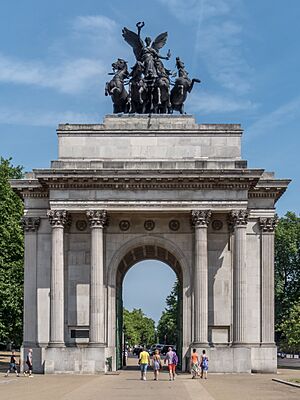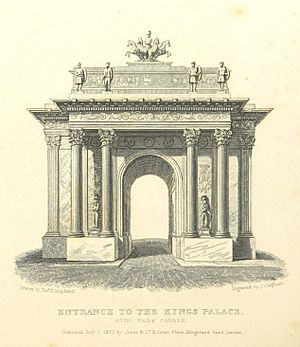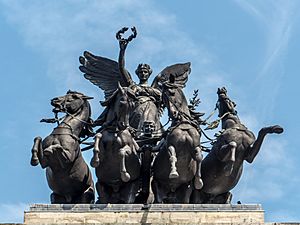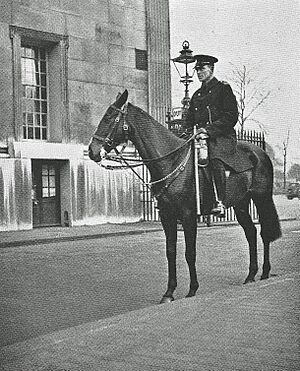Wellington Arch facts for kids
The Wellington Arch is a famous triumphal arch in central London. You might also hear it called the Constitution Arch. It stands proudly at Hyde Park Corner, where Hyde Park and Green Park meet. This amazing arch is on a large island in the middle of a busy road. People can cross safely to visit it.
The arch was built between 1826 and 1830. It wasn't always in its current spot. It used to be a bit further east. In 1882–1883, it was moved to the top of Constitution Hill. When it was first built, a huge statue of the 1st Duke of Wellington stood on top. That's how it got its name! Since 1912, a beautiful bronze statue called Peace descending on the Quadriga of War has been on the arch. It shows Nike, the goddess of victory, riding a quadriga (a chariot pulled by four horses).
Contents
Building the Wellington Arch
Why Was the Arch Built?
Both the Wellington Arch and Marble Arch were planned in 1825. King George IV wanted to celebrate Britain's wins in the Napoleonic Wars. During the late 1820s, the King and his team decided to make Hyde Park and the surrounding area look grand. They wanted it to be as splendid as other big cities in Europe. The main idea was to create a magnificent entrance to the newly finished Buckingham Palace.
A special committee, led by Prime Minister Lord Liverpool, chose Decimus Burton as the architect. Burton was known for his beautiful and correct designs. He wanted to create a special place that celebrated Britain's royal family, national pride, and heroes.
Designing the Park and Arch
Work on Hyde Park, Green Park, and St James's Park began in 1825. New roads and paths were made. Burton then designed new gates and lodges in a classical style. These included Cumberland Gate, Stanhope Gate, and the Hyde Park Gate at Hyde Park Corner. His designs were admired for their simple and elegant look.
At Hyde Park Corner, the King wanted a grand entrance for Buckingham Palace. Burton suggested a gateway, a classical screen, and a triumphal arch. People approaching the palace from the north would ride through the screen, then the arch. After that, they would turn left down Constitution Hill to reach the palace. The screen became the beautiful Hyde Park Gate. The triumphal arch became the Wellington Arch.
Burton's first design for the arch was based on the Arch of Titus in Rome. It was very well-designed and matched the screen. However, the committee wanted something more showy. They preferred a design like the Arch of Constantine. So, Burton created a new, much larger design. This new plan was approved in 1826 and became the Wellington Arch we see today.
The arch has one main opening and uses the Corinthian order style. Many of the planned decorations were left out. This was to save money because the King was spending a lot on Buckingham Palace at the same time. The original plan included a richly carved top section. It was also meant to have statues of warriors on each column. A figure in a four-horse chariot was planned for the very top.
The Arch's Sculptures
The First Statue: A Big Problem
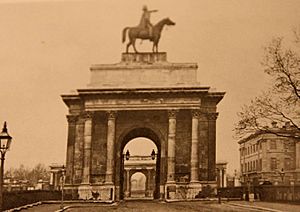
The Wellington Arch was left without its planned decorations for a while. Then, a huge statue of the Duke of Wellington was placed on it. This was against Decimus Burton's wishes. The sculptor was Matthew Cotes Wyatt. This bronze statue was enormous, weighing 40 tons and standing 28 feet (8.5 meters) high. It was the largest horse-riding statue ever made at the time. Many people thought Wyatt was not a very talented artist.
Sir Frederick Trench and others wanted the statue on Burton's arch. Burton strongly disagreed. He felt the statue was too big and would "disfigure" his arch. It also had to be placed across the roadway, which was not how classical arches were designed. Burton had imagined a much smaller four-horse chariot on top. Most people in London agreed with Burton.
Even the Prime Minister, Sir Robert Peel, thought another spot would be better. He offered other locations, but the statue's supporters refused. Almost everyone in Parliament wanted the statue somewhere else. Decimus Burton himself wrote that the huge statue would make his arch look like "a mere pedestal." He feared it would ruin the arch's design. He even said he would prefer the arch to stay empty rather than have such a huge statue on it.
Despite all the objections, the government placed the Wellington statue on the arch in autumn 1846. Many people thought it looked "ridiculous." A magazine called The Builder wrote that it "must come down." They said it ruined both the arch and the statue itself. The debate about removing the statue became a national topic. Even visitors from other countries thought the statue and arch looked strange together.
The Current Statue: Victory's Chariot
In 1882, London's traffic was getting very busy at Hyde Park Corner. People suggested moving Burton's arch to make more space. This led to a new campaign to remove the Wellington statue. The campaign was successful! Wyatt's statue was moved to Aldershot. In 1883, the arch was moved to Constitution Hill.
A new statue, a quadriga by Captain Adrian Jones, took its place. While not as elegant as Burton's original idea, it fits the arch much better than the old statue. Its figures are also lined up correctly with the road below.
Jones's statue was inspired by a smaller version that King Edward VII liked. It shows Nike, the winged goddess of victory. She is riding a war chariot and holding a laurel wreath, a symbol of victory. The face of the charioteer is that of a small boy. This boy was the son of Lord Michelham, who paid for the sculpture. The angel of peace was modeled by Beatrice Stewart. This statue is the largest bronze sculpture in Europe.
The boundary of Buckingham Palace Garden was moved. A new road, Duke of Wellington Place, was created. This separated the arch from the rest of Green Park.
Visiting the Wellington Arch
The Wellington Arch is hollow inside. Until 1992, it held London's smallest police station! In 1999, English Heritage took over the arch. Now, you can pay to go inside and explore. There are three floors of exhibits that tell the arch's history. You can also enjoy amazing views of the surrounding area from high terraces on both sides of the arch. One part of the arch also works as a ventilation shaft for the Hyde Park Corner road tunnel, which was built in 1961–1962.
See also
 In Spanish: Arco de Wellington para niños
In Spanish: Arco de Wellington para niños


